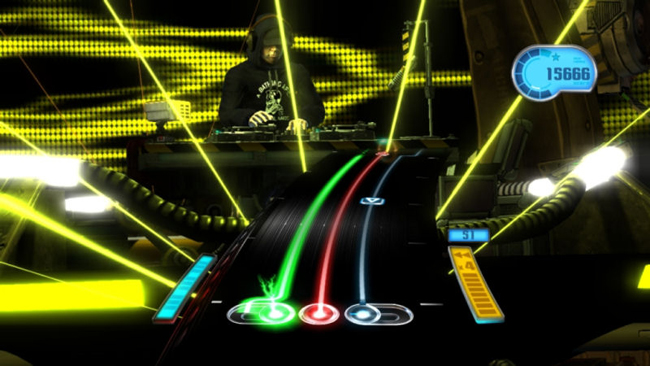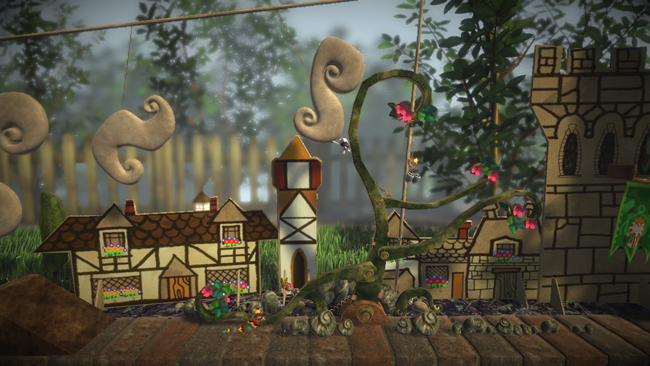First things first: This study is by no means a definitive round-up of what went down at E3 this year. I am merely compiling my observations of trends that I noticed while perusing the show floor and keeping track of the announcements made throughout the week. There were several notable trends forming and continuing from previous years, from user interface to graphical aesthetics to game mechanics. In this article I intend to highlight those themes in hopes that it will help others take a better understanding of where the gaming industry is heading both short- and long-term.
And away we go!
This year, E3 (the Electronic Entertainment Expo) saw a return to form as a large-scale event. With it’s growth in size also came an influx of new games and product announcements from almost every major game publisher. The three days I spent on (and off of) the show floor allowed me to view and play several hundred video games in what seemed like a nearly exhaustively epic LAN party. While playing, several themes and trends began to become apparent. I’ve divided this article into three parts: user interaction, game design, and the gaming “sphere” which encompasses much more about how we enjoy games than a disk in a console.
User Interaction
Trend: Motion Control
The most apparent theme developing this year was the re-focus on motion control as an important play mechanic. Over 3 years ago, both Nintendo and Sony debuted motion-controlled gaming with their introduction of the WiiMote and the Sixaxis, respectively. Once thought of as a gimmick, the WiiMote is now firmly intertwined in some of the most memorable recent gaming experiences.
This year, Microsoft debuted the first concept for their “controller-less” motion control: a stereo camera that can track 48-points of motion and depth, facial recognition, and audio/voice recognition. Game play was shown on screen in several ways: a painting game, kickball, and interaction with a life-like virtual boy, Milo. The technology pushes the limits of human-machine interaction to levels only thought possible in distant science fiction films. The first development kits for the technology have supposedly recently shipped, with an expected date for the product to debut to be around late 2010 – early 2011.
Sony, not to be out-done, debuted their “magic wand” during their press conference. This peripheral, a sort of WiiMote/camera hybrid, allows a wand to be tracked on screen via camera. Sony — and to the same extent Nintendo — claim that gamers still want to push buttons and hold controllers as part of their interaction. The wand allows for full 1-to-1 motion as well as character mapping on-screen. With the camera, the player can appear in the game with exact motion of the wand. The concept showed a live image of the player holding the wand on screen which morphed into a sword, baseball bat, and mace depending on gaming necessity. Expected arrival is late 2010.

Nintendo, the often-criticized grandfathers of motion-control technology, debuted the first production-ready update to the original WiiMote, the WiiMotion Plus add-on that simulates 1-to-1 motion much more accurately than the original controller ever did. In fact, Nintendo was forced to scale back the effectiveness of the motion in games as it was too exact, creating awkward movement relative what was taking place on screen. The product is available now.
Also shown were Nintendo’s “Vitality Sensor”, a sort of finger scanner that theoretically measures heart rate, stress, and emotion, and the motion-controlling skateboard for Tony Hawk’s RIDE, as well as several peripherals from third-party suppliers (like a Wii bowling ball). The emphasis on motion gaming is huge. However, so is the splintering and segregating of the market even further than it is now. Will the console-makers force developers to adopt one method — such as games from now on requiring a a new controller to function — or will there be two tiers of gaming per console: standard controller and motion? The possibilities to move gaming forward are incredible. The paradigm shift taking place is quicker than many may have thought, accelerated by the possible fruits and heavy risks of innovation.
Trend: Intuitive HUD & Information Delivery
A second major trend in the way that we interact with games is how information is delivered to us. Typically, heads-up displays were accessed by pausing the game, stopping the on-screen momentum. As seen in last year’s Dead Space the HUD can be something that takes place in-game, creating a more realistic and intuitive access of information. This year, games continued that trend. Splinter Cell: Conviction utilized messages scrawled on walls, signs, and images to symbolize the main character’s memories and thoughts, which directly related to what the aims of the current mission were. Split/Second, a racing game from Black Rock Studio (the creators of Pure) lowers the camera angle to be slightly more parallel to the road. The space underneath the car now becomes the location for the HUD, freeing up the rest of the screen for the intense game visuals. With HD gaming in full effect, visual space is more important… Anything that designers can do to reduce HUD interference is optimal.
Trend: Buzz Words
The way games are interacted with is obviously changing. The trend to constantly innovate in human-machine interface has always been a focus at E3 and this year wasn’t any different. The major buzz words this year revolved around intuitive, realistic results from interaction with games. Bethesda, the publishers of Brink, used “kinesthetics” to explain how the game “feels to interact with”. Their thought: movement and actions should not be hindered by button layout or confusing interaction. By pressing the action button when moving, the game’s S.M.A.R.T. system – Smooth Movement Across Random Terrain – allows the character to slide, jump, or interact with the terrain without the need to analyze whether to take a specific action. The result is constant, fluid motion.
In their showing of the game/app Milo, Lionhead Studios crossed into the uncanny valley of technology. This divide, where realism is almost achieved, creates an Artificial Intelligence in both interaction and visual appearance that can startle the player as the interaction is “real” yet “not quite right”. This divide will remain in technology for the foreseeable future, until artificial intelligence becomes true artificial life.
Scribblenauts, a game for the Nintendo DS, utilizes innovation to create a “wow” experience in a small scale. When the player reaches a problem on-screen that needs solving a virtual keyboard is brought up. The player is then prompted to type in the name of an object, any object. Is there an iceberg in your path? Call for a flamethrower, or a hot sun, or fire-breathing dragon to melt it. In most cases the game is able to accurately represent the object in-game, allowing for virtually endless opportunities to replay and interact with the game.
As innovation in gaming continues, these buzz words are used as selling points to separate the games from each other in unique, interactive ways.
Game Design
Trend: Forests are the new Water
A few years ago, it was the render quality of water. Last year, fire was all the rage in game visuals. This year at E3 lush, vibrant, green forests were a common sight. In games such as Uncharted 2: Among Thieves the plumage in and around buildings was heavily featured to create the mood of being lost in an exotic town. In God of War III and the trailer for The Last Guardian for the Playstation 3, the greenery was interspersed amongst ancient ruins. Perhaps this trend is reflective of TV shows such as LOST having had their effect on pop culture. Regardless, the ability to show living, moving shrubbery is more common than ever.
Trend: Blue is the new Brown
To go along with the lushness of island life and exotic ruins, game developers are incorporating more blue and bluish-gray tones in their game visuals. Assassin’s Creed 2‘s Renaissance setting utilizes the more calming tones of the blue end of the spectrum throughout, and Brink’s Ark city seems to be built using blue bricks. Gone are the rusty, dirty hues of Far Cry 2 and Fallout 3 as developers look to bring life back into gaming.
Trend: Racing Games
Just when we thought racing games were dying, the ability to see sports cars and detailed race tracks in High Definition has spurred a renaissance in the game genre. From the long-awaited updates of Gran Turismo 5 and Gran Turismo PSP, to the reality-induced Forza 3, to the user-generated kart racing of Mod Nation Racers and the recent refresh of the Need for Speed series racing is once again a focus for developers, as one-upsmanship is on the return.
Trend: Music Games Will. Not. Die.

Yes, yes, I know: music rhythm gaming isn’t necessarily a new trend. However, this may be the strongest year ever for the genre as perennials like Guitar Hero and Rock Band birth epic sequels in GH 5, Band Hero, Beatles: Rock Band and Lego Rock Band. Also on deck (sorry, bad pun) are newcomers DJ Hero and Scratch: The Ultimate DJ, both of which have great potential to be fun, as well as new peripherals to spend cash on. And, with as much fun as The Beatles and DJ Hero were to play (or watch someone else play) there will be no shortage of music gaming at least for this year.
Trend: Emphasis on Storytelling
Videogames are always criticized for their usual lack of high-quality storytelling. Over the last few years in the gaming industry, games like Bioshock and Fallout 3 have begun to push storytelling to new limits. This year, that trend is ever more apparent. With Splinter Cell: Conviction storytelling is the driving factor in the game’s development and the character’s progression throughout. Missions are displayed as memories scrawled on walls, guiding the character and filling in the blanks to the narrative without stopping and slowing the pace of the game. In Alan Wake, the player takes control of a character who’s life begins to mimic the story he is writing. Throughout the day, Wake is able to scout the town and try to solve the mystery of his wife’s disappearance. By night, his world turns into a nightmarish hell filled with fear. Light and darkness play an important role in telling the story of good versus seemingly demonic evil. Heavy Rain for the PS3 intertwines exploration, dialogue, and action in a unique way: at any time in the game, the playable character’s thoughts can be made visible. Depending on the stress of the situation the thoughts, which correspond to action buttons, move around and blur in and out of focus, depicting what the character is most likely to react to.
Storytelling has moved far beyond the traditional cut scene or quick-time-event into something that is fluidly built into the gameplay. This constant fluid narrative is blurring the lines ever more between games and interactive films.
The Gaming Sphere
Trend: Social Networking

As gaming evolves, so do the networks around the gaming industry. Initially, a service such as XBox Live revolved around connecting players in multiplayer matches with access to instant messaging and simple communication methods. Now, full social networking has been realized in gaming and gaming communities. Where once there were just message boards, now reside communities such as GamerDNA which aim to bring gamers together that in unique ways. GamerDNA allows for the ability to broadcast your gaming habits to friends or to notify them via Facebook and Twitter integration when you are online playing a specific game. The aggregated data of gaming habits, along with offshoot TweetMyGaming, allow for possible information gathering on trending game topics and popular games.
Microsoft recently announced Facebook and Last.FM integration into XBox Live, and Nintendo announced the ability to send images captured and edited via the DSi directly to a Facebook account over WiFi. Sony has been developing its own social landscape, Home, into a gaming avatar hub for the PS3.
Whether in game, or integrated into how we play games, the social network sphere of gaming is growing.
Trend: User-Generated Content

The final trend I want to cover is the continued evolution and acceptance of user-generated content. Last year, Sony pioneered the trend on consoles with Little Big Planet for the PS3. The game ushered in a completely user-created gaming methodology of “Play. Create. Share.” This year, other developers are making headway in the direction as well.
Sony is offering Little Big Planet soon for the PSP, with full user-generated content in tow. It is also bringing Mod Nation Racers, a fully user-created kart racing game to the PS3. In it, players can create race tracks on the fly and in incredibly speedy time. Nintendo is bringing Wario Ware to the DSi as a downloadable app used to make the microgames, the popular game’s genre of mini-games. Mario vs Donkey Kong: March of the Minis brings user-created levels to the game. The levels are shareable over Nintendo’s WiFi network and with friends. Games like EyePet allow the player to sketch on paper (actual paper, that is) and let the camera read/scan it to interact with the pet on-screen.
User-generated content is making a much bigger push this year on the home gaming market as the trend becomes something that gamers are beginning to expect from some titles.
Finally
This report on trends was just the tip of the proverbial ice berg of what was shown at the E3 game industry expo this year. Under the giant fluorescent lights it was possible to get caught up playing one game or another for far too long, unknowingly missing out on another potentially unique experience. If there is anything that E3 is known for each year it is that it always brings these unique experiences, regardless of show size or attendance. The amount of innovation in the video game industry rivals that of other media, and as more games are made trends do develop. Hopefully by analyzing these trends we can, if anything, look forward to creating and playing terrific and innovative games in the years to come.
Written by: Dalibor Dimovski, Managing Editor – SideQuesting.com
Twitter.com/kewlrats
[Feel free to re-post and re-distribute this article under Creative Commons, or as long as credit is given via link back to the original.]



9 Comments